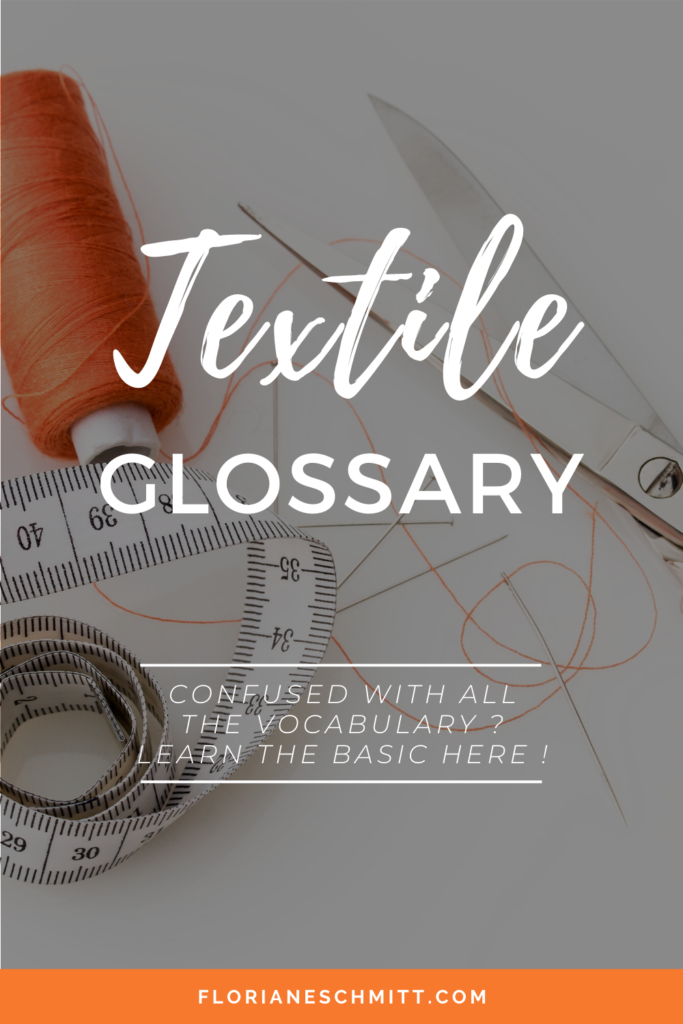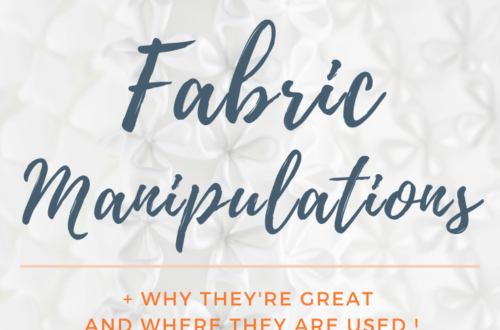
Textile Glossary
Because fabrics and everything around it comes with a lot of technical words and complicated stuffs, let’s recap a few of the basic words in this Textile Glossary !
This is not an exhaustive list of vocabulary around textile [this would require an entire website and fill a dictionary !] but rather an introduction to the fundamental knowledge around fabric. I’ll be adding new words regularly, so bookmark this post for later !
If the name is orange and underlined, it’s a link to a blog post I wrote ! Click on it to discover more about it.
Textile Glossary, from A to Z :
Artificial Fibers/Fabrics : Any fibers that originated from nature that we chemically transformed. A fabric made entirely of those fiber would be called artificial fabric, although it’s not that common in use. The main artificial fibers are viscose, rayon, Cupro, Lyocell, etc [To learn more, see the dedicated post about Artificial fibers and all types of fibers]
Canadian Smocks : A type of fabric manipulation, made by stitching the fabric together at key places, to create a 3D pattern.
Cloth : Ancient word, used to indicate mostly cotton or woolen pieces of fabric. But today, it can but used as a synonym of fabric.
Cottons : A category of fabrics, that mostly are made of cotton or linen fibers [To learn more, see the dedicated post about Cottons and all types of fabric]
Creative Process : The name of the techniques and systems followed by designers to create new and innovative ideas, concept or products. [Each designer can have its own, mine is a 5-Steps Process that I’m sharing right here : The 5-Steps Creative Process]
Crochet : A type of fabric manipulation, or a technique to make fabrics, using a crochet hook to intertwine loops of yarn. [Did you know that the name is actually French ? It means “small hook” 🙊]
Damask : a monochromatic Jacquard that plays with satin weave to make the pattern appear when light hits the fabric.
Dyeing : A type of finishing. It’s the action of coloring fabric or yarn. Depending on the composition of the item you want to dye, you’ll use different coloring.
Embroidery : A type of fabric manipulation that aim to embellish the surface of a fabric, sewing different material on it like threads, yarns, ribbons, beads, sequins, etc. A lot of different techniques exists (by hand, machine, Luneville, etc) as well as infinite patterns.
Fabric : Any type of textile, made by any construction/manufacturing technique such as weaving, knitting, crocheting, or bonding. This term is mostly used in the fashion industry
Fabric Hand : Each fabric has different properties, such as drape, thickness, texture, structure, composition, etc. This all creates a special reaction of the fabric when we take it in our hands ; and that’s what we call the fabric hand. A lot of adjectives can be used to qualify the fabric hand, such as compact, springy, fluid, stiff, crisp, mellow, airy, etc.
Fabric Manipulations : Techniques that reshape a fabric or textile surface. Making textile manipulations (or fabric manipulations) is playing with the fabric to change its appearance, drape or shape. It is a type of Finishing.
Fiber : The raw material used to create yarns and fabrics. It can be natural or man made.
Finishings : All the operations that modifies the fabrics are called finishings. They can embellish it and/or giving it new properties. Fabric manipulations are a type or finishing, as well as dyeing, printings, coating, etc.
Jacquard : a special technique that allows the creation of colored pattern in a fabric. Named after its inventor, Joseph Marie Jacquard, it consist of a card system with holes, that select or not each yarns, to make it visible or not. It was invented for woven fabrics, but has been also adapted to knits machine. It’s also the systems we use to make lace by machine instead of by hand !
Knit/Knitting : A type of fabric construction. Knitted fabric is made by yarns looped on themselves. Their structure makes the knitted fabrics more soft, and stretching in several directions.
Knits : A category of fabrics, made by the knitting technique [see “Knit” above, and check out the dedicated post to learn more about Knits and all types of fabric]
Lace : A category of fabrics [to learn more, see the dedicated post about Lace and all types of fabric]
Leather & Furs : A category of “textiles” [see the dedicated post about Leather + Furs and all types of fabric]
Linings : A category of fabric used to make the inside of clothes. [To learn more, see the dedicated post about Linings and all types of fabric]
Man-made fibers : All the fibers used to make fabrics that were not found in nature. They are divided in artificial, and synthetic fibers. [To learn more, see the dedicated post about Man-made fibers and all types of fibers]
Microfibers : any fiber that is thinner than Silk (silk being the thinnest natural fiber)
Natural Fabric/Fibers : All fibers extracted from nature, such as silk, cotton, wool are called natural. The fabric composed exclusively of those fibers is called a natural fabric. [To learn more, see the dedicated post about Natural fibers and all types of fibers]
Non-woven : A type of fabric construction, made by a jumble of fibers bonded together. [see the dedicated post about Non-wovens and all types of fabric]
Pleating : A type of fabric manipulation, made by pressing and heating the fabric. For big, precise and deep pleats, cardboard pleating is prefered. It consist of sandwiching the fabric between 2 pieces of pleated cardboard, then heating so the fabric takes the shape of the cardboards. For smaller and irregular pleats, machine pleating is better. There, the fabric is wrinkled randomly.
Printing : A finishing technique that consist of deposing pigments or a dying material at a specific place on top of the fabric. A lot of different techniques exists, such as traditional printing, transfer, silkscreening, digital printing… The printed pattern can printed all-over, or placed.
Rushing : A type of fabric manipulation, that consist of gathering, pleating or repeatedly folding a fabric
Silkies : A category of fabrics, mostly made of Silk and similar-looking fibers, that contains all the fabrics having the aspect of silk [see the dedicated post about Silkies and all types of fabric]
Smocks : A type of fabric manipulation, made by pleating the fabric and adding patterns with threads. Not to be confused with Canadian Smocks.
Synthetic Fabric/Fibers : Synthetic refers to a 100% man-made material. Synthetics fibers are made in labs, and the fabric made with them is also called synthetic. Most common synthetic fibers include polyester, polyurethane, and polyamid. [see the dedicated post about Synthetic fibers and all types of fibers]
Technicals : A category of fabrics, mostly used in sportswear and athleisure, that have specific properties such as water-repellent, breathable, fire-proof, etc [see the dedicated post about Technicals and all types of fabric]
Textile : It’s a very general term, used to describe either a two-dimensional material made of fibers, or an industry (clothing, interior, industrial textiles)
Threads : Small and thin yarns, used for sewing fabrics together
Tulle : A type of fabric construction, made by spacing and double twisting yarns together. It is the foundation of laces.
Warp : Refers to the yarns used vertically in a woven fabric
Weave : In a woven fabric, the weave is the pattern used to cross the warp and weft. A lot of different pattern exists, such as plain weave, satin, herringbone, twill…
Weaving : A piece of woven fabric. Often relates to artisanal/artistic work
Weft : Refers to the yarns used horizontally in a woven fabric
Wools : A category of fabrics, that includes fabrics made out of wool fibers, and fabrics that mimics wool [To learn more, see the dedicated post about Wools and all types of fabric]
Woven Fabric : A type of fabric construction, made by holding yarns tight, and crossing perpendicularly. The vertical yarns are called warp, the horizontal are called weft
Yarns : Composed of natural or man-made fibers, yarns are intertwined together to form fabrics or knits. Yarn’s properties, such as thickness, cleanness, regularity, twist, texture… play a role in the fabric’s properties and look.
Are you looking for a specific fabric name ? Go to this website, the owner did a great job at explaining very simply the different fabric names !
Some nice & simple definitions can also be found there : Fabric Dictionary
Do you want to learn about a specific word ? Ask for the definition in the comments, I’ll add it for you !
Pin this for later !


Floriane Schmitt is a textile designer, sharing her knowledge about textiles + creativity. She graduated with honors at a Parisian fashion school in Fashion Design & Fashion Business, and started her career with Flo Home Delight, her creative textile studio. Discover her collections on www.flohomedelight.com. She is also teaching creative souls how to become better designers, using textile as a main medium.



